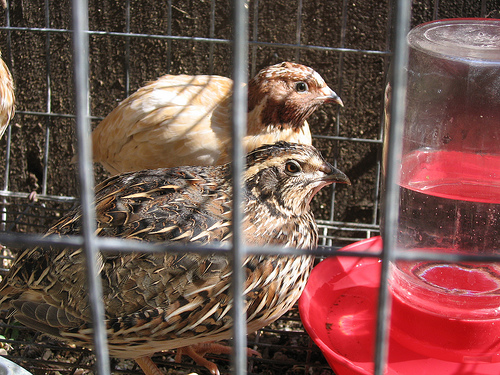Unknown to many, quails (Coturnix coturnix japonica) are classified as game birds and used in outdoor sports and recreational activities. However, for business, quail is more than just a game bird. Raising quails is a profitable venture as the birds are easy to nurture. It does not require construction of large holding pens, minimum capital, and can give immediate returns. In fact, quails can stand well with chicken as a source of organic meat and eggs.

In the Philippines, quail eggs, known as itlog ng pugo, have become popular “street food;” sold boiled or as orange-colored kwek-kweks. On the other hand, quail meat is usually boiled, baked, roasted, stir-fried, or stewed.
Quail hens require less than two pounds of feed to produce a pound of egg, while chicken needs almost three pounds of feeds to produce the same weight of egg. It can produce an egg daily for at least a year.
In spite of the economic potential of quail farming, it has not attracted the interest of large-scale investors and producers because of lack of information, particularly on feeding. This is the motivation behind the project of the Department of Agriculture-Livestock Development Council to develop modern yet simple strategies for raising quail.
At present, there are six breeds of quail raised for commercial production here and abroad. These are Japanese Seattle, Silver, Negro, Japanese Taiwan/Chinese quail, Tuxedo, and Brown crosses 1 and 2.
Start it right
Anyone who wants to venture into the quail business should first consider the proper selection of stock. Closely examine the bird’s physical attributes to avoid growth abnormalities. For beginners, start with 30-35 days old quail pullets. The feathers should be tidy and neat, without any streak of white and black, as these could be signs of inbreeding. Birds should also be uniform in size. A mature (60-day old) Japanese quail normally weighs 120 grams while an American quail (30-35-day old) has an average weight of 100 grams. It is important to record the laying performance of the parent stock. A 65% average laying efficiency within 300 days laying period is desirable.
Management
Keep quails in small and safe pens. Preferably, cages for layers should be 5 to 6 inches high. Since quails are very agile birds, one should not provide too much space to minimize the risk of injuries.
Regulate the temperature to 850F on the 10th day after the birds have developed enough feathers by using gas lamps or electric bulbs.
The brooding, which lasts up to 15 days, is the most critical stage in a quail’s life. Adequate amount of feeds and water, and optimum temperature minimize the mortality rate at 5% to 8% level.
Transfer healthy 15-day old birds to growing cages. Limit light exposure to not more than 12 hours. Normally, quail hens start to lay eggs 45 days from hatching. Critical factors to consider are feeding, water, culling, waste removal and lighting.
Feeding is a major factor in raising quails. Most of the quail industries today fail because raisers are still practicing inappropriate techniques such as feeding the quail birds with chicken feeds. Quails require a higher percentage of protein in their feeds. If sustained with chicken feeds for a long period, mortality rate may reach up to 70% and “survivors” will not be efficient layers. In addition, quails are sensitive to salt; therefore, levels should not exceed 0.7% to 1% in feeds.
Quails fed with chicken mash undergo early molting, thus affecting egg production efficiency. Supplement laying mash for layers with chopped green vegetables.
Sustain birds raised for meat production with high-carbohydrate diets and special feeds formulated that are commercially available.
There is no known serious disease of quail except for some respiratory disorders do not spread fast. The remedy for this is regular cleaning and disinfecting.
Place newly laid eggs in carton boxes and store in cool and dry places to maintain good air circulation. This keeps the eggs fresh for seven days.
——————————-
Source:
Livestock Development Council, Department of Agriculture, Elliptical Road, Diliman, Quezon City.
Tel.No 920-3990/920-3991 or email: [email protected]
BAR Chronicle, December 2001 Issue (Vol. 2 No. 23-24)
